Peterbilt 587 Operator's Manual
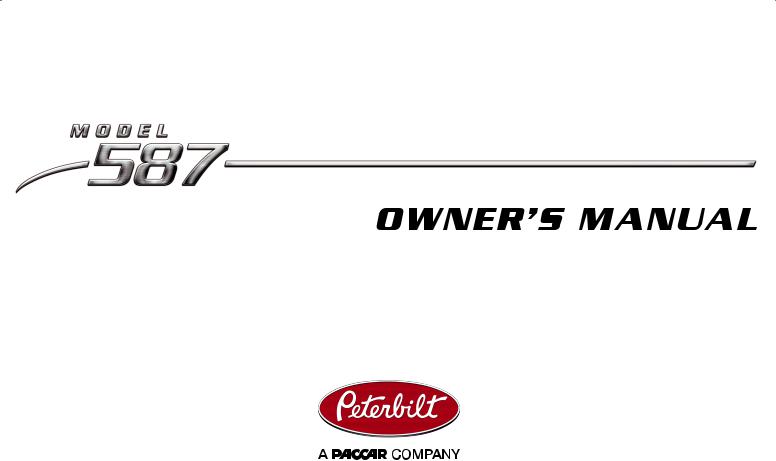

Quick Table of Contents
Introduction . . . . . . . . . . . . . . . . . . 1
Cab And Frame Access . . . . . . . . . . . . 6
Getting To Your Engine . . . . . . . . . . . . . . 11
Controls And Displays. . . . . . . . . . . . . . . . . . . 14
Seat And Restraint Systems . . . . . . . . . . . . . . . . . 75
Driver’s Checklists . . . . . . . . . . . . . . . . . . . . . . . . . . . 88
Starting And Operating The Vehicle . . . . . . . . . . . . . . . . . . 93
Maintenance and Service . . . . . . . . . . . . . . . . . . . . . . . . . . 143
Vehicle Identification . . . . . . . . . . . . . . . . . . . . . . . . . . . . . . . . . . . 229
Consumer Information . . . . . . . . . . . . . . . . . . . . . . . . . . . . . . . . . . . . . 230
Subject Index . . . . . . . . . . . . . . . . . . . . . . . . . . . . . . . . . . . . . . . . . . . . . . . 233
© 2010 PACCAR INC - All Rights Reserved
This manual illustrates and describes the operation of features or equipment which may be either standard or optional on this vehicle. This manual may also include a description of features and equipment which are no longer available or were not ordered on this vehicle. Please disregard any illustrations or descriptions relating to the features or equipment which are not on this vehicle.
Peterbilt reserves the right to discontinue, change specifications, or change the desing of its vehicles at any time without notice and without incurring any obligation.
The information contained in this manual is proprietaary to Peterbilt. Reproduction, in whole or in part, by any means is strictly prohibited without prio written authorication from PACCAR Inc.

PART 1: INTRODUCTION |
HOW TO FIND WHAT YOU WANT |
PART 1: INTRODUCTION
This manual contains useful information for the safe and efficient operation of your Peterbilt Model 587. It also provides information on maintaining your vehicle in the best condition, with an outline for performing safety checks and basic preventive maintenance inspections.
We have tried to present the information you’ll need to learn about your vehicle’s functions, controls, and opera- tion—and to present it as clearly as possible. We hope you’ll find this manual easy to use.
Please remember, though—this manual is not a training manual. It can’t tell you everything you need to know about driving your Peterbilt vehicle. For that you need a good training program or truck driving school. If you have not been trained, get the proper training before you drive. Only qualified drivers should drive this vehicle.
There will be times when you need to take this manual out of your Peterbilt. When you do, please be sure to return it to the cab when you are finished using it. That way it will be there when you need it the next time or when you pass the vehicle on to the next user.
How To Find What You Want
There are several tools built into this manual to help you find what you need quickly and easily.
First is the Quick Table of Contents. Located at the front of the manual, this lists the main subjects covered and gives page numbers where you can find these subjects. Use the Quick Table of Contents to find information on a large subject like “Maintenance.”
Cross-referenced citations also help you get the information you need. If some other part of the manual contains further information on the subject you are reading about, we’ll indicate that in a cross-reference like this: (See “PART 6: DRIVER’S CHECKLIST”). You won’t have to go searching for more information.
Finally you’ll find a helpful Subject Index. It’s in the back of the manual and alphabetically lists the subjects covered. So if you want information on brakes, for example, just look under Brake in the Subject Index. You’ll find all the pages listed where brakes or braking are discussed.
(R05/10) |
Y53-6032 |
– 1 – |

A SPECIAL WORD ABOUT REPAIRS |
PART 1: INTRODUCTION |
A Special Word About Repairs
Your Peterbilt dealer’s service center is the best place to have your vehicle repaired. You can find Peterbilt dealers all over the country with the equipment and trained personnel to get you back on the road quickly—and keep you there.
Your vehicle is a complex machine. Anyone attempting repairs on it needs good mechanical training and the proper tools. If you are sure you have these requirements, then you can probably perform some repairs yourself. However, all warranty repairs must be performed by an authorized Peterbilt service facility. If you aren’t an experienced mechanic, or don’t have the right equipment, please leave all repairs to an authorized service facility. They are the ones equipped to do the job safely and correctly.
WARNING! Attempting repair work without sufficient training, service manuals, and the proper tools can be dangerous for yourself and others. You could be injured or you could make your truck unsafe and cause death or serious injury. Do only those tasks you are fully qualified to do.
Maintenance Manuals. If you do decide to do any complex repair work, you’ll need the Peterbilt Maintenance manuals. Order them from your authorized dealer. Please provide your Chassis Serial Number when you order, to be sure you get the correct manuals for your vehicle. Allow about four weeks for delivery. There will be a charge for these manuals.
Final Chassis Bill of Material. A complete, nonillustrated computer printout listing of the parts used to custom-build your Peterbilt vehicle is available through the Peterbilt dealer from whom your purchased your vehicle.
WARNING! Modifying your vehicle can make it unsafe. Some modifications can affect your truck’s electrical system, stability, or other important functions. Before modifying your vehicle, check with your dealer to make sure it can be done safely.
Additional Sources of Information
Operator’s manuals are also supplied by the manufacturers of components such as the engine, seats, transmission, and radio in your Peterbilt. If you are missing any of these manuals, ask your Peterbilt dealer to supply them.
– 2 – |
Y53-6032 |
(R05/10) |

PART 1: INTRODUCTION |
SAFETY SIGNALS |
Another place to learn more about trucking is a local truck driving school. Contact one near you to find out what kinds of instruction it offers.
Federal agencies such as The National Highway Traffic Safety Administration and the Federal Motor Carrier Safety Administration also have information and various agencies in state governments are sources for regulations that differ from state to state.
Safety Signals
A number of alerting messages are in this manual. Please read and follow them. They are there for your protection and information. These messages can help you avoid injury to yourself and others, as well as prevent costly damages to the vehicle.
Key symbols and “signal words” are used to indicate what kind of message is going to follow. Pay special attention to instructions prefaced by symbols and the signal words “WARNING”, “CAUTION”, and “NOTE”. Please do not ignore any of these alerts.
WARNING
When you see this word, the message that follows is especially vital. It signals a potentially hazardous situation which, if not avoided, could result in an injury or death. This message will tell you what the hazard is, what can happen if you don't heed the warning, and how to avoid it.
Example:
WARNING! Never carry additional fuel containers in the vehicle. Such containers, full or empty, may leak, explode or cause a fire in the event of a collision.
CAUTION
 Signals a potentially hazardous situation which, if not avoided, could result in property or vehicle damage.
Signals a potentially hazardous situation which, if not avoided, could result in property or vehicle damage.
Example:
CAUTION: Continuing to operate your vehicle with insufficient oil pressure will cause serious engine damage.
(R05/10) |
Y53-6032 |
– 3 – |
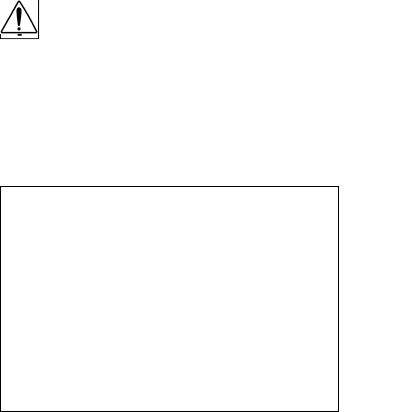
VEHICLE SAFETY |
PART 1: INTRODUCTION |
NOTE
Provides general information: for example, the note may suggest how to operate the vehicle more efficiently.
Example:
NOTE: Pumping the accelerator will not assist in starting the engine.
Please take the time to read these messages when you see them, and remember:
WARNING!
Something that could seriously injure or kill you or others.
CAUTION:
Something that could cause property or vehicle damage.
NOTE:
Useful information.
Vehicle Safety
Make sure your Peterbilt is in top working condition before heading out on the road—it is the responsible driver's duty to do so. Inspect the vehicle according to “PART 6: DRIVER’S CHECKLIST”.
WARNING! Do not drink and drive. Your reflexes, perceptions, and judgment can be affected by even a small amount of alcohol. You could have a serious—or even fatal acci- dent—if you drive after drinking. Please do not drink and drive or ride with a driver who has been drinking.
WARNING! The use of alcohol, drugs, and certain medications will seriously impair perception, reactions, and driving ability. These circumstances can substantially increase the risk of an accident and death or personal injury.
Please remember, this manual is not a training manual. It cannot tell you everything you need to know about driving your Peterbilt vehicle. For that you need a good training
– 4 – |
Y53-6032 |
(R05/10) |

PART 1: INTRODUCTION |
VEHICLE SAFETY |
program or truck driving school. If you have not been trained, get the proper training before you drive. Only qualified drivers should drive this vehicle.
Safe driving is only possible with the proper concentration on the driving task. Keep distraction to a minimum to improve your concentration. Examples of distractions may include radio controls, GPS navigation controls, cellular telephone calls, cellular text messages, reading or reaching for something on the floor. Minimizing your distractions will improve safe driving and will help avoid an accident involving death or personal injury.
Be aware of local regulations that may prohibit the use of cellular telephones while driving. In addition to being an unsafe practice, it may be against local ordinances to use cellular devices while operating the vehicle.
Every new Peterbilt vehicle is designed to conform to all Federal Motor Vehicle Safety Standards applicable at the time of manufacture. However, even with these safety features, continued safe and reliable operation depends greatly upon regular vehicle maintenance. The vehicle must be operated within the range of its mechanical capabilities and the limits of its load ratings. (See the Tire and Rim Weight Ratings label on the driver's door edge.)
(R05/10) |
Y53-6032 |
– 5 – |

PART 2: GETTING INTO & OUT OF THE CAB AND FRAME ACCESS
PART 2: GETTING INTO & OUT OF THE CAB AND FRAME ACCESS
Be careful whenever you get into or out of your vehicle’s cab. Always maintain at least three points of contact with your hands on the grab handles and your feet on the steps.
WARNING! Do not jump out of the cab or get into the cab without proper caution. You could slip or fall, possibly suffering death or serious injury. You could slip and fall if the steps are wet or icy, or if you step in fuel, oil, grease, snow or mud.
The illustrations that follow show the best ways to enter and exit a cab.
02958-A
Vehicle With External Grab Handle
– 6 – |
Y53-6032 |
(R05/10) |

PART 2: GETTING INTO & OUT OF THE CAB AND FRAME ACCESS |
DOOR LOCK AND KEYS |
02958-B
Vehicle Without External Grab Handle
Door Lock and Keys
Doors can be locked from the inside by using the lock button. Close the door then push the button down to lock. Doors automatically unlock when you open them from inside, and can be locked from the outside with the key only. To lock or unlock the doors from outside the cab, insert the key in the lock. Turn the key toward the rear to lock; forward to unlock.
WARNING! To help lessen the chance and/or severity of death or personal injury in case of an accident, always lock the doors while driving. Along with using the lap shoulder belts properly, locking the doors helps prevent doors from inadvertently opening and occupants from being ejected from the vehicle.
Remote Keyless Entry (optional)
This vehicle may be equipped with a Remote Keyless Entry (RKE) system that adds security and convenience to your vehicle. The system will lock or unlock the driver’s door and passenger’s door with the key fob and alert you with parking lights when the selected door’s are locked or unlocked. The system includes two key fobs that provide secure rolling code technology that prevents someone from recording the entry signal.
Operation
To unlock the driver’s door, press the UNLOCK button once. The driver's door will unlock and the parking lights will come on for 40 seconds.
To unlock the passenger’s door press the UNLOCK button once and press again within 5 seconds.
(R05/10) |
Y53-6032 |
– 7 – |

DOOR LOCK AND KEYS |
PART 2: GETTING INTO & OUT OF THE CAB AND FRAME ACCESS |
To lock both doors press the LOCK button. The doors will lock and the parking lights will come on for 2 seconds. If the doors are open they will not lock. The range of the RKE system should be approximately 30 ft. This will be reduced if it is operated close to other RF sources such as TV/radio transmitters and cell towers.
Batteries
The key fob uses one CR2032, 3V battery. Batteries should last approximately three years, depending on use. Consistently reduced range is an indicator that the battery needs replacement. Batteries are available at most discount, hardware and drug stores.
The battery is located under the back cover of the key fob. Be sure to synchonize the key fob every time you replace the batteries.
Synchronization
The key fob may need to be synchronized to the truck when the battery is replaced or when the key fob has not been used for an extended period time.
To Synchronize A Key Fob
1. Hold the key fob near the receiver.
NOTE: The receiver is located behind the Speedometer/Tachometer cluster assembly.
2.Press and hold both the Lock and Unlock buttons at the same time for approximately 7 seconds.
3.When the key fob is resynchronized, the doors will lock then immediately unlock.
4.If the fob fails to synchronize, it could be programmed to a different truck or could have failed. Contact your dealer to re-program your key fob.
– 8 – |
Y53-6032 |
(R05/10) |

PART 2: GETTING INTO & OUT OF THE CAB AND FRAME ACCESS |
CLIMBING ONTO THE DECK PLATE |
FCC ID: L2C0031T IC: 3432A-0031T
FCC ID: L2C0032R IC: 3432A-0032R
This device complies with Part 15 of the FCC Rules and with RSS-210 of Industry Canada. Operation is subject to the following two conditions:
1.This device may not cause harmful interference, and
2.This device must accept any interference received, including interference that may cause undesired operation.
WARNING: Changes or modifications not expressively approved by the party responsible for compliance could void the user's authority to operate the equipment. The term “IC:” before the radio certification number only signifies that Industry Canada technical specifications were met.
Climbing Onto the Deck Plate
When you are climbing onto and off the deck plate, maintain at least three points of contact with your hands on the grab handles and your feet on the steps.
NOTE: Any alteration (adding bulkheads, headache racks, tool boxes, etc.) behind the cab or sleeper that affects the utilization of grab handles, deck plates, or frame access steps installed by Peterbilt must comply with FMCSR 399.
WARNING! Do not step on vehicle components without antiskid surfaces or use components not designed for entry-and-exit use. You could fall and kill or injure yourself if you step onto a slippery surface. For example:
•Do not step onto the surface of a fuel tank. A fuel tank is not a step. The tank surface can get very slippery, and you might not be able to prevent a fall.
•Use only the steps and handholds provided, not chain hooks, quarter fenders, etc.
•Do not climb onto and off the deck plate— use steps and grab handle provided. If there is no deck plate, or if proper steps and grab handles are not provided, do not climb onto the area behind the cab.
•Do not climb onto or stand on the frame rails. The frame rails are very slippery and could cause you to fall, resulting in death or personal injury.
•Always reinstall steps before entering the cab or accessing the deck plate. Without steps, you could slip and fall, resulting in possible injury to yourself.
(R05/10) |
Y53-6032 |
– 9 – |
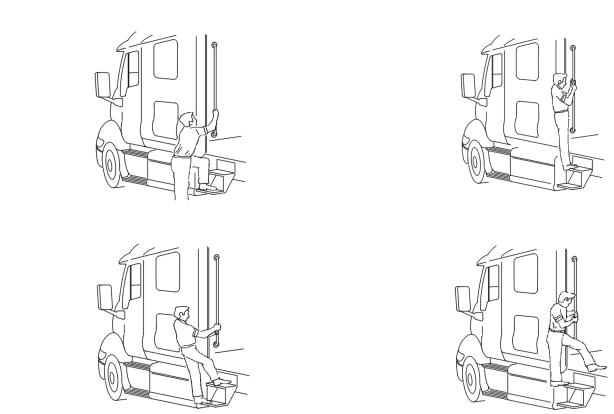
CLIMBING ONTO THE DECK PLATE |
PART 2: GETTING INTO & OUT OF THE CAB AND FRAME ACCESS |
Hold handles as you step up |
Three points of contact as you reach the deck area |
Three points of contact |
|
Three points of contact as you step to the deckplate |
– 10 – |
Y53-6032 |
(R05/10) |
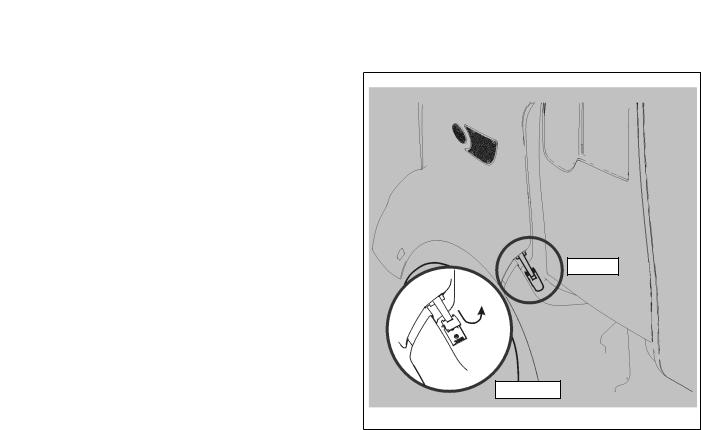
PART 3: GETTING TO YOUR ENGINE |
HOOD HOLD DOWNS |
PART 3: GETTING TO YOUR ENGINE
Hood Hold Downs
Hood hold downs keep a hood from opening unexpectedly.
CAUTION: A hood not latched securely could open during operation and cause vehicle damage. Be sure to latch the hood securely.
Hood Tilt
Follow this procedure to tilt the hood.
WARNING! A pivoting hood could hurt someone or be damaged itself. Before opening or closing the hood, be sure there are no people or objects in the way. Failure to stand in a position of safety can cause death or personal injury.
1.To open your hood, unlock the hood hold downs by unlatching them. Put one hand on the top of the hood front, one foot on the bumper, and one foot on the ground. Tilt the hood forward.
LATCHED
UNLATCHED
(R05/10) |
Y53-6032 |
– 11 – |

HOOD TILT |
PART 3: GETTING TO YOUR ENGINE |
2.Locate the hood anti-blowdown device mounted to the driver side hood dampener.
WARNING! The hood uses two struts to control movement during opening and closing. Do not tilt the hood with one or both struts disconnected. Replace damaged, worn, or leaking struts as soon as possible. Tilting a hood with either strut disconnected or defective may cause the hood to tilt too rapidly. You could be killed or injured and the hood could be damaged.
3.Verify that the device was previously reset during the last hood closing event. This is done by pulling the collar in the downward direction.
WARNING! Always verify that the hood antiblowdown device has been reset when opening the hood. The device is reset either by fully closing the hood or by manually pulling the device down. Failure to reset the antiblowdown device may lead to a hood closing unintentially which can cause death or personal injury to anyone under the hood.
PULL DOWN TO
RESET DEVICE
Hood antiblowdown device
– 12 – |
Y53-6032 |
(R05/10) |
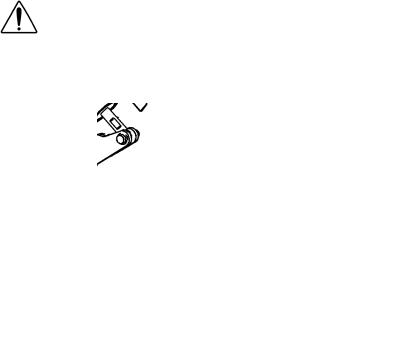
PART 3: GETTING TO YOUR ENGINE |
HOOD TILT |
4.To close the hood, disengage the hood antiblowdown device by pushing it in the upward direction. The device will move about 1/4” up the shaft. You may feel a click when the device disengages.
PUSH UP TO
DISENGAGE
DEVICE
CAUTION: Attempting to close a hood without disengaging the hood antiblowdown device may cause equipment or vehicle damage.
5.Firmly push upward and rearward on the hood ornament to start the hood tilting backwards. Continue to push until the hood comes is fully closed.
6.Secure the hood latches on both sides of the vehicle to hold the hood in the closed position.
WARNING! If the hood is not latched securely, it could open during operation and cause an accident involving death or injury. Be sure the hood is latched securely before moving the vehicle.
(R05/10) |
Y53-6032 |
– 13 – |

YOUR INSTRUMENT PANEL |
PART 4: CONTROLS AND DISPLAYS |
PART 4: CONTROLS AND DISPLAYS
This part explains the location of the various features on your vehicle and describes their function. For information on using these features in driving, see the paragraphs below.
Your Instrument Panel
Please remember that each vehicle is custom-made. Your instrument panel may not look exactly like the one in the pictures that follow.
We have tried to describe the most common features and controls available, so your vehicle may not have some of the ones that appear in this section. You can pick out the parts that apply to you and read them to be fully informed on how your particular vehicle operates.
WARNING! Use extreme caution when using devices while driving (such as cellular telephones) that distracts you from safe driving practices. Failure to properly concentrate on the driving task can result in an accident involving death or personal injury. Limit the use of such devices to when it is safe to do so; not while operating the vehicle.
– 14 – |
Y53-6032 |
(R05/10) |

PART 4: CONTROLS AND DISPLAYS YOUR INSTRUMENT PANEL
Typical Cab Instruments and Controls |
|
|
LEFT SIDE |
|
|
||||||||||
|
|
|
|
|
|
|
|
|
|
|
1. |
Hazard Switch |
10. |
Oil Pressure |
|
|
6 |
7 |
8 |
9 |
10 |
11 |
12 |
|
2. |
Ignition Switch |
11. |
Primary Air Pressure |
|||
|
|
|
|
|
|
|
|
||||||||
|
|
|
|
|
|
|
|
3. |
Headlight Light Switch |
12. |
Secondary Air Pressure |
||||
|
|
|
|
|
|
|
|
|
|
|
|||||
5 |
|
|
|
|
|
|
|
|
|
|
4. |
ID/Clearance Lamps Switch |
13. |
Fuel |
|
4 |
|
|
|
|
|
|
|
|
13 |
|
5. |
Voltmeter |
14. |
Cigarette Lighter |
|
|
|
|
|
|
|
|
|
|
|
|
|
|
|
|
|
|
|
|
|
|
|
|
|
|
|
|
6. |
Engine Coolant Temp |
15. |
Menu Control Switch |
|
|
|
|
|
|
|
|
|
|
14 |
|
|
7. |
Tachometer |
16. |
Rear A/C Switch |
|
|
|
|
|
|
|
|
|
|
|
|||||
3 |
|
|
|
|
|
|
|
|
15 |
|
|
||||
|
|
|
|
|
|
|
|
|
|||||||
|
|
|
|
|
|
|
|
|
|
|
|
|
|
||
|
|
|
|
|
|
|
|
|
|
|
8. |
Driver Information Display |
17. |
Dome Light Switch |
|
2 |
|
1 |
|
|
|
|
|
|
16 |
|
|
9. |
Speedometer |
18. |
Panel Dimmer |
|
|
18 |
|
|
|
|
|
|
|||||||
|
|
|
|
|
|
|
|
|
|
|
|
|
|
||
|
|
|
|
|
|
17 |
|
|
|
|
|
|
|
||
|
|
|
|
|
|
|
|
|
|
|
|
|
|
||
|
|
|
|
|
|
|
|
|
|
|
|
|
|
|
|
|
|
|
|
|
|
|
|
|
|
|
|
|
|
|
|
|
|
|
|
|
|
|
|
|
|
|
|
|
|
|
|
(R05/10) |
Y53-6032 |
– 15 – |

YOUR INSTRUMENT PANEL |
PART 4: CONTROLS AND DISPLAYS |
10 |
11 12 |
13 14 |
15 |
|
|||
|
|
|
16 17 |
9 |
|
|
|
8 |
|
|
|
|
|
|
18 |
7 |
|
|
19 |
|
|
|
|
6 |
|
|
20 |
5 |
|
|
21 |
4 |
|
|
|
2 1
3
RIGHT SIDE
1. |
Parking Brake Valve |
12. |
Optional |
2. |
Trailer Air Supply Valve |
13. |
Engine Brake |
3. |
Heater/AC Control Panel |
14. Engine Brake Sel |
|
4. |
Engine Fan Switch |
15. |
Interaxle Differential Lock |
|
|
|
Switch |
5. |
Floor Light Switch |
16. |
5th Wheel Lock Switch |
6. |
Regeneration Switch |
17. |
Air Suspension Switch |
7. |
Load Light Switch |
18. |
Radio |
8. |
Fog Lights Switch |
19. |
CB Radio |
9. |
Cruise Control Switch |
20. |
Traction Control Switch |
10. |
Transmission Temperature |
21. |
Mirror Heater Switch |
11. |
Cruise Control Sel Switch |
|
|
– 16 – |
Y53-6032 |
(R05/10) |

PART 4: CONTROLS AND DISPLAYS |
INSTRUMENTS AND CONTROLS |
Instruments And Controls
Menu Control Switch (MCS)
The MCS is used to navigate the Driver Information Display unit. The Menu Control Switch is located on the D Panel as shown in the illustration below.
Standard Warning Lights and Audible Alarm
The warning lights and audible alarm may indicate a system malfunction. Check the lights frequently, and respond properly as soon as you see one go on. These lights could save you from a serious accident.
WARNING! Do not ignore a warning light or audbile alarm. These signals tell you something is wrong with your vehicle. It could be a failure in an important system, such as the brakes, which could lead to an accident involving death or personal injury. Have the appropriate system checked immediately.
 3
3
2
The MCS has the following functions:
1
•Rotating the MCS
–Selecting display
|
1. |
Driver Information Display |
2. Status Indicator |
– Setting values |
3. |
Light Bar |
|
•Pushing the MCS
–Confirming desired selection
(R05/10) |
Y53-6032 |
– 17 – |

INSTRUMENTS AND CONTROLS |
PART 4: CONTROLS AND DISPLAYS |
Warning lights and indicator symbols will be shown in both areas 1 and 2. Area 3 includes the turn and high beam indicator symbols.
1. Driver Information Display:
The display can show up to six warning lights. Warnings do not have fixed positions and are displayed in order of criticality. The most critical warning will be displayed on the top row and to the left. If more than six warnings are active, the menu control switch (MCS) can be used to scroll through the additional warnings.
2. Status Indicator:
Additional lights and indicator symbols are displayed in the Status Indicator. They are limited to:
a.Park Brake
b.Transmission Gear (Automatic transmissions only)
c.Warnings:
Number of active warnings.
A red warning is active.
An amber warning is active.
d.Cruise Control - active
e.Clock alarm bell
Refer to “Warning Light / Indicator Symbols” on page 20 for information on each symbol.
Instrument System Self Test:
When the ignition switch is turned on the instrumentation system will undergo a Self Test. This test will verify the operation of the gauges and warnings.
During the Instrumentation System Self Test, three screens will sequentially display warning icons (approximately 3 seconds each screen) on the Information Display. These are:
– 18 – |
Y53-6032 |
(R05/10) |
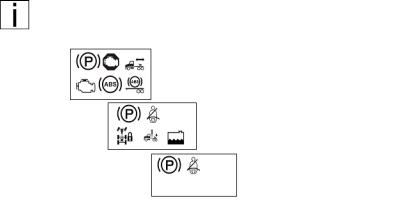
PART 4: CONTROLS AND DISPLAYS |
INSTRUMENTS AND CONTROLS |
First
Second
Third
Refer to “Warning Light / Indicator Symbols” on page 20 for information on each symbol.
Completing this sequence will indicate a successful Self Test. Have your instrumentation system checked by a qualitfied service technician if does not successfully complete.
Audible Alarm:
The audible alarm will sound during the Instrumentation System Self Test. The audible alarm will also sound in conjunction with most warning lights. These events
include but are not limited to headlight on, fifth wheel, stop engine, primary/secondary air, and driver door open warnings.
Optional Lights:
Additional lights may be operational depending on individual vehicle specifications. These will be included in the Instrument System Self Test.
NOTE: Some optional lights may illuminate even though your vehicle is not equipped with that particular feature.
(R05/10) |
Y53-6032 |
– 19 – |

INSTRUMENTS AND CONTROLS |
PART 4: CONTROLS AND DISPLAYS |
Warning Light / Indicator Symbols
The following is a list of Warning Light / Indicator Symbols. Reading left to right, the table header identifies
•the Symbol Name
•the appearance of the Symbol
•the Symbol Color when it is illuminated
•whether the symbol is standard (Std) or optional (Opt)
•the Page Number reference for additional information Symbols are listed by major component sections.
Example: Engine, and then in alphabetical order.
Warning Light / Indicator Symbols
|
Symbol Name |
Symbol |
Color |
Std |
Opt |
Page |
|
|
|
|
|
|
|
1. Active Warnings, Exclamation |
|
Red |
|
|
23 |
|
Point |
|
|
|
|||
|
|
|
|
|
|
|
2. |
Active Warnings, Number |
|
Yellow |
|
|
23 |
|
|
|
|
|
||
|
|
|
|
|
|
|
3. |
Active Warnings, Triangle |
|
Yellow |
|
|
23 |
|
|
|
|
|
||
|
|
|
|
|
|
|
4. |
Alternator |
|
Red |
|
|
23 |
|
|
|
|
|
||
|
|
|
|
|
|
|
5. |
Anti-Lock Brake System |
|
Yellow |
|
|
23 |
(ABS) |
|
|
|
|||
|
|
|
|
|
|
|
6. |
Anti-Lock Brake System |
|
Yellow |
|
|
24 |
(ABS), Trailer |
|
|
|
|||
|
|
|
|
|
|
|
7. |
Axle, Inter-Axle Differential |
|
Yellow |
|
|
24 |
Locked (Tandem Axles) |
|
|
|
|||
|
|
|
|
|
|
|
8. |
Clock, Alarm Bell |
|
Yellow |
|
|
24 |
|
|
|
|
|
||
|
|
|
|
|
|
|
9. |
Cruise Control, Active |
|
Yellow |
|
|
24 |
|
|
|
|
|
||
|
|
|
|
|
|
|
– 20 – |
Y53-6032 |
(R05/10) |
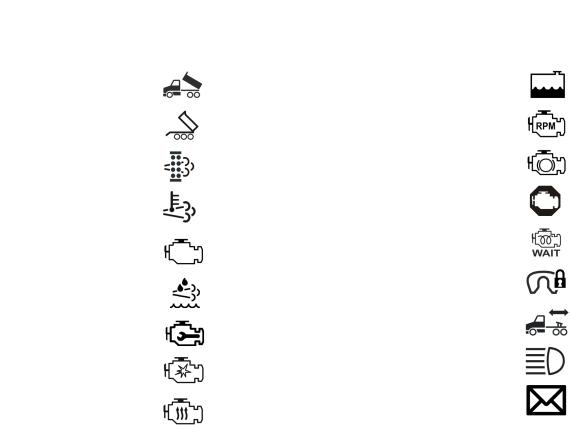
PART 4: CONTROLS AND DISPLAYS |
INSTRUMENTS AND CONTROLS |
Warning Light / Indicator Symbols
|
Symbol Name |
Symbol |
Color |
Std |
Opt |
Page |
|
|
|
|
|
|
|
10. |
Dump Truck, Body Up |
|
Yellow |
|
|
24 |
|
|
|
|
|
||
|
|
|
|
|
|
|
11. Dump Truck, Trailer Body Up |
|
Yellow |
|
|
25 |
|
|
|
|
|
|
||
|
|
|
|
|
|
|
12. |
Emissions, Diesel Particu- |
|
|
|
|
25 |
late Filter (DPF) |
|
Yellow |
|
|
||
|
|
|
|
|
|
|
13. |
Emissions, High Exhaust |
|
Yellow |
|
|
25 |
System Temperture (HEST) |
|
|
|
|||
|
|
|
|
|
|
|
14. |
Emissions, Malfunction Indi- |
|
Yellow |
|
|
26 |
cator Lamp |
|
|
|
|||
|
|
|
|
|
|
|
15. |
Emission, Diesel Exhaust |
|
Yellow |
|
|
26 |
Fluid Lamp |
|
|
|
|
||
|
|
|
|
|
|
|
16. |
Engine, Check Engine |
|
Yellow |
|
|
26 |
|
|
|
|
|
||
|
|
|
|
|
|
|
17. |
Engine, Ether Start |
|
Green |
|
|
26 |
|
|
|
|
|
||
|
|
|
|
|
|
|
18. |
Engine, Heater |
|
Yellow |
|
|
26 |
|
|
|
|
|
||
|
|
|
|
|
|
|
Warning Light / Indicator Symbols
|
Symbol Name |
Symbol |
Color |
Std |
Opt |
Page |
|
|
|
|
|
|
|
19. |
Engine, Low Coolant Level |
|
Yellow |
|
|
26 |
|
|
|
|
|
||
|
|
|
|
|
|
|
20. |
Engine, Overspeed |
|
Red |
|
|
27 |
|
|
|
|
|
||
|
|
|
|
|
|
|
21. |
Engine, Retarder (Brake) |
|
Green |
|
|
27 |
|
|
|
|
|
||
|
|
|
|
|
|
|
22. |
Engine, Stop Engine |
|
Red |
|
|
27 |
|
|
|
|
|
||
|
|
|
|
|
|
|
23. |
Engine, Wait To Start |
|
Yellow |
|
|
27 |
|
|
|
|
|
||
|
|
|
|
|
|
|
24. |
Fifth Wheel, King Pin Lock |
|
Red |
|
|
27 |
|
|
|
|
|
||
|
|
|
|
|
|
|
25. |
Fifth Wheel, Slide Unlocked |
|
Red |
|
|
27 |
|
|
|
|
|
||
|
|
|
|
|
|
|
26. |
Lights, High Beam |
|
Blue |
|
|
28 |
|
|
|
|
|
||
|
|
|
|
|
|
|
27. |
Message Waiting |
|
Green |
|
|
28 |
|
|
|
|
|
||
|
|
|
|
|
|
|
(R05/10) |
Y53-6032 |
– 21 – |

INSTRUMENTS AND CONTROLS |
PART 4: CONTROLS AND DISPLAYS |
Warning Light / Indicator Symbols
|
Symbol Name |
Symbol |
Color |
Std |
Opt |
Page |
|
|
|
|
|
|
|
28. |
Park Brake |
|
Red |
|
|
28 |
|
|
|
|
|
||
|
|
|
|
|
|
|
29. |
Power Take-off (PTO) |
|
Green |
|
|
28 |
|
|
|
|
|
||
|
|
|
|
|
|
|
30. Power Take-off (PTO), Pump |
|
Green |
|
|
28 |
|
Mode |
|
|
|
|||
|
|
|
|
|
|
|
31. |
Refrigerator |
|
Green |
|
|
28 |
|
|
|
|
|
||
|
|
|
|
|
|
|
32. |
Seat Belt, Fasten |
|
Red |
|
|
28 |
|
|
|
|
|
||
|
|
|
|
|
|
|
33. |
Suspension Dump |
|
Yellow |
|
|
28 |
|
|
|
|
|
||
|
|
|
|
|
|
|
34. |
Tire Inflation |
|
Yellow |
|
|
29 |
|
|
|
|
|
||
|
|
|
|
|
|
|
35. |
Transmission, Auxiliary |
|
Yellow |
|
|
29 |
|
|
|
|
|
||
|
|
|
|
|
|
|
36. |
Transmission, Check |
|
Red |
|
|
29 |
|
|
|
|
|
||
|
|
|
|
|
|
|
Warning Light / Indicator Symbols
|
Symbol Name |
Symbol |
Color |
Std |
Opt |
Page |
|
|
|
|
|
|
|
37. |
Transmission, Do Not Shift |
|
Red |
|
|
29 |
|
|
|
|
|
||
|
|
|
|
|
|
|
38. |
Transmission, Oil Filter |
|
Yellow |
|
|
29 |
|
|
|
|
|
||
|
|
|
|
|
|
|
39. |
Transmission, Oil Tempera- |
|
Yellow |
|
|
29 |
ture High |
|
|
|
|||
|
|
|
|
|
|
|
40. |
Turn Signal, Left |
|
Green |
|
|
29 |
|
|
|
|
|
||
|
|
|
|
|
|
|
41. |
Turn Signal, Right |
|
Green |
|
|
29 |
|
|
|
|
|
||
|
|
|
|
|
|
|
– 22 – |
Y53-6032 |
(R05/10) |
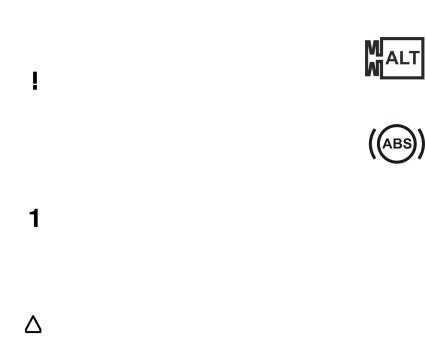
PART 4: CONTROLS AND DISPLAYS |
INSTRUMENTS AND CONTROLS |
Warning Light/Indicator Symbol Descriptions
1. Active Warnings, Exclamation Point
Illuminates when a red warning is active. Use the MCS knob to view the warnings that are active. Refer to the preceeding Figure , “Warning Light / Indicator Symbols,” on page 20 for warning color classification.
2. Active Warnings, Number
Illuminates the total number of red and yellow active warnings. Use the MCS to view the active warnings if the display shows a > symbol.
3. Active Warnings, Triangle
Illuminates when an yellow warning is active. Use the MCS knob to view the warnings that are active. Refer to the preceeding Figure , “Warning Light / Indicator Symbols,” on page 20 for warning color classification.
4. Alternator
Illuminates if the alternator is not charging. (For alternators with warning lamp output signal.)
5. Anti-Lock Brake System (ABS)
Illuminates during the Instrumentation System Self Test. Have the ABS system checked by a Peterbilt dealer if the ABS Warning Lamp stays on for more than 3 seconds.
Illuminates during normal operating conditions to indicate a problem with the ABS System. See “ABS Warning Lamps” on page 109 for more information.
Illuminates when a problem exists with the optional Wheel Spin Control feature. See “Advanced ABS with Stability Control” on page 106 more information.
(R05/10) |
Y53-6032 |
– 23 – |
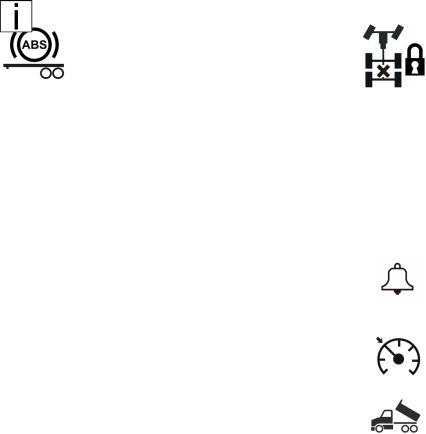
INSTRUMENTS AND CONTROLS |
PART 4: CONTROLS AND DISPLAYS |
6.Anti-Lock Brake System (ABS), Trailer
Illuminates during the Instrumentation System Self Test and the tractor/truck is connected with a ABS equipped trailer.
Illuminates during normal operating conditions to indicate a problem with the Trailer ABS System. This should be checked by a Peterbilt dealer as soon as possible. See “Truck/Tractor ABS Warning Lamp” on page 109 for more information.
NOTE: Tractors/Trucks and trailers built after 3/1/ 01 must be able to turn on an In-Cab Trailer ABS Warning Lamp (per U.S. FMVSS121). The industry chose Power Line Communication (PLC) as the standard method to turn it on. See “Trailer ABS Warning Lamp” on page 110 for more information. On trailers built prior to 3/1/01 verify trailer ABS system status via the required external warning lamp mounted on the trailer. The indicator lamp on the trailer should be yellow and identified with the letters "ABS".
7. Axle, Inter-Axle Differential Locked
(Tandem Axles)
Illuminates when the inter-axle differential switch is ON thus locking the inter-axle differential. This powers the forward rear and the rear rear differentials equally. When the switch is turned off (inter-axle differential unlocked) the engine power is allowed to flow to any of the 4 drive tires based on the differential effect (mostly to the forward rear differential). (This feature is standard on all tandem axles).
8.Clock, Alarm Bell
Illuminates when the alarm is set. It will flash when the clock alarm is active.
9. Cruise Control, Active
Illuminates when cruise control is active.
10.Dump Truck, Body Up
Illuminates when Truck Dump Body is up.
– 24 – |
Y53-6032 |
(R05/10) |

PART 4: CONTROLS AND DISPLAYS |
INSTRUMENTS AND CONTROLS |
11.Dump Truck, Trailer Body Up
Illuminates when Trailer Dump Body is up.
12.Emissions, Diesel Particulate Filter (DPF)
Illuminates when diesel particulate trap is plugged. This warning will also illuminate when regeneration operation is disabled.
NOTE: Refer to “Exhaust After-Treatment System” on page 126 for more information regarding this warning icon.
13.Emissions, High Exhaust System Temperture (HEST)
Illuminates when the exhaust gas temperature and exhaust components become extremely hot.
Refer to “Exhaust After-Treatment System” on page 126 for more information regarding this warning icon.
WARNING!Temperatures of the exhaust pipes and at the outlets of the exhaust system during and shortly after a regeneration event will be extremely hot. If the High Exhaust System Temperature (HEST) warning lamp is on:
•Do not park in an area of combustible vapors or materials. You must keep combustibles at least five (5) feet away from the side and top of the vehicle while the HEST light is illuminated. Always park your vehicle outside. Failure to do so could ignite an explosion or harm bystanders which could result in death or serious injury.
•Do not park in an area where people are close by. You must keep bystanders at least five (5) feet away from the exhaust outlet while the HEST light is illuminated. Failure to do so could result in death or serious injury.
•The exhaust piping, diesel particular filter (DPF) or tail pipe become extremely hot during engine operation or any regeneration event and can cause death or serious burns
(R05/10) |
Y53-6032 |
– 25 – |
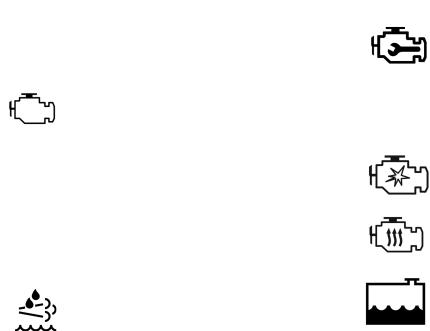
INSTRUMENTS AND CONTROLS |
PART 4: CONTROLS AND DISPLAYS |
to the skin. Allow adequate cooling time before working on or near any part of the exhaust system.
14.Emissions, Malfunction Indicator Lamp
Illuminates when an engine emissions failure has occurred. The vehicle can be safely driven but should be serviced to correct the problem. The situation should not be considered an emergency. In some cases, the Malfunction Indicator Lamp will activate in conjunction with the High Exhaust Temperature, Diesel Particulate Filter (DPF) and Diesel Emission Fluid (DEF) Warning Lights.
15. Emission, Diesel Exhaust Fluid Lamp
Illuminates when the Diesel Exhaust Fluid (DEF) tank level is low. The vehicle can be safely driven but the DEF tank should be filled at the next opportunity. The situation should not be considered an emergency.
16.Engine, Check Engine
Illuminates when a problem exists, but the vehicle can still be safely driven. Vehicle should be serviced to correct the problem but the situation should not be considered an emergency.
17.Engine, Ether Start
Illuminates when ether start switch is on.
18. Engine, Heater
Illuminates when Engine Heater switch is on.
19. Engine, Low Coolant Level
Illuminates with an audible alarm indicating critically low coolant level. The vehicle must be serviced to correct the problem but the situation should not be considered an emergency.
– 26 – |
Y53-6032 |
(R05/10) |

PART 4: CONTROLS AND DISPLAYS |
INSTRUMENTS AND CONTROLS |
20. Engine, Overspeed
Illuminates when engine RPM is exceeded.
21. Engine, Retarder (Brake)
Illuminates when the engine retarder (compression brake or exhaust brake) switch is turned on. (Engine retarders are an option.)
22. Engine, Stop Engine
Illuminates and an audible alarm tone will sound when a major engine system problem exists.
WARNING! This should be considered an emergency. You should stop the vehicle as safely as possible and turn OFF the ignition. The vehicle must be serviced and the problem corrected before driving again. Failure to do so may cause severe engine damage or cause an accident involving death or personal injury.
23. Engine, Wait To Start
Illuminates when engine grid heater is on (Cummins ISB and ISC engines).
24. Fifth Wheel, King Pin Lock
Illuminates when air actuated fifth wheel King Pin is unlocked.
25. Fifth Wheel, Slide Unlocked
Illuminates and an audible warning tone will sound when the air operated sliding fifth wheel switch is on, thus unlocking the sliding fifth wheel. The light and an audible warning tone should NOT be considered an emergency but simply as a reminder to turn off the switch to lock the sliding fifth wheel before driving. This switch should not be operated while driving. (Sliding fifth wheels are an option).
(R05/10) |
Y53-6032 |
– 27 – |

INSTRUMENTS AND CONTROLS |
PART 4: CONTROLS AND DISPLAYS |
26. Lights, High Beam
Illuminates when the high beams are on. This icon will flash with audible alarm if the headlamps are left on when the door is open. In addition, this icon will flash, but without an audible alarm, if there is a problem with the low beam headlights or the low beam headlight wiring. In such event, the high beam headlights will turn on at 50% normal brightness.
27. Message Waiting
Illuminates with telematic equipped messaging.
28. Park Brake
Illuminates in the status indicator when parking brakes are applied and the vehicle is stationary. This symbol will also illuminate in the Driver Information Display if the parking brakes are applied and the vehicle is in motion.
29.Power Take-off (PTO)
Illuminates when the PTO is engaged.
NOTE: Do not drive vehicle with PTO engaged.
30.Power Take-off (PTO), Pump Mode
Illuminates with remote throttle application. Indicates pump mode is active.
31. Refrigerator
Illuminates to indicate that the refrigerator is on and ignition is off.
32. Seat Belt, Fasten
Illuminates when the ignition key is turned on as a reminder to fasten your seat belt.
33.Suspension Dump
Illuminates when suspension air bags are deflated.
– 28 – |
Y53-6032 |
(R05/10) |
